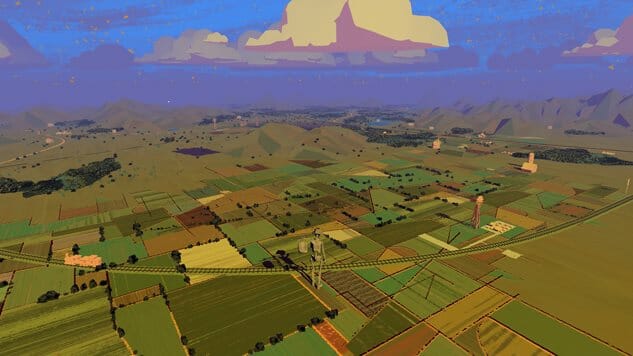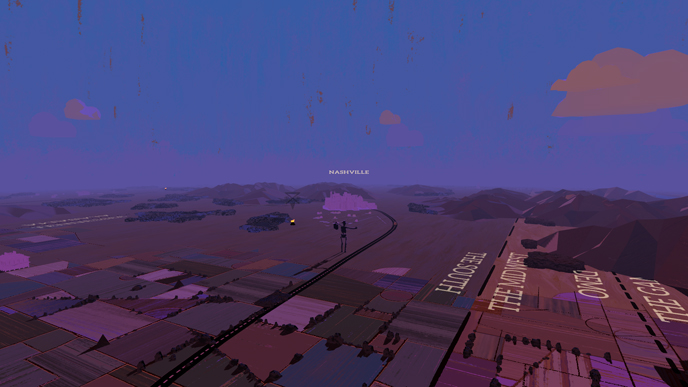
In game design there’s a lot of talk about “narrative-driven” games, how some virtual experiences sit outside the objective-based conventions that for many have come to define the medium. But in the case of Where the Water Tastes Like Wine, the narrative is the mechanics, as in how that narrative is shaped, changed and formed. Both in subject matter and the development process itself, the game is an homage to the role of collaborative retelling in the tradition of folklore.
The concept behind Where the Water Tastes Like Wine was developed in-context. Following the success of Gone Home, Fullbright Studios co-founder Nordhagen decided, in the summer of 2014, to go on an extended backpacking trip around the world, making a point to avoid planes and travel instead by train, bus, boat, and on foot. “I like those methods and I feel they give a greater appreciation of the distance traveled and the terrain and feeling of a place.” he explains. “I met other folks, traded stories about our travels, and gave advice on where to go next or where to avoid.” It was while he was on the Trans-Siberian Railway (“thinking a lot, because there’s not a lot else to do on a week-long train trip across Siberia but think”) that he decided he wanted to actually make a game about traveling. Not anything combat-based or focused on combat, but instead a game that could capture the feeling of trading stories with other people.
“I wanted to pull in music somehow, especially the American roots music I am very much into. I also decided I wanted to consider America and the American dream and the traditional American road story, and how the feelings of freedom and travel played into that.” says Nordhagen. “The folklore followed soon after. I can’t remember the exact journey that took me there, but I found some way to sew all of that up together in a neat package, traveling by train in America combined with folk music leads naturally to think of hoboes and the Great Depression, which has a lot to say about the American Dream. I also realized that what else is the American Dream but the greatest of folktales?
I wanted to show how the stories we tell each other and ourselves weave together to create the idea of the place where we live, and that idea shapes our reality.”
Early on in the writing process, Nordhagen realized he couldn’t possibly write all the characters himself. While Fullbright Games co-founder Steve Gaynor had had success previously in researching the experiences of queer girls in the ‘90s for the writing of Gone Home, the themes, perspectives, and subject matter of Where the Water Tastes Like Wine are too vast for Nordhagen to take the same approach.
Says Nordhagen, “Who can write a story this broad, yet detailed, and respectful of such disparate histories as that of black sharecroppers in the South and Navajo women in the desert? I don’t think that any one person could. Or should, or something.” It was at that point he decided that the best way to make sure the stories of his game were told right was to get different people to write different stories, an idea that fit the game’s anthology-like structure.
Eventually, he reached out to various sources introduced to him by his PR rep Felix Kramer, first approaching (former Paste assistant editor and my predecessor) Gita Jackson. From there, they began to develop a format that additional writers would come to base their own storyteller’s narrative on.
“At the time the player got a random hand of Tarot cards and playing a card was like asking a vague question,” Nordhagen says. “The idea of trading stories, strangely, came later, even though that was the whole basis for the game.” From there, he continued to reach out through Kramer and other avenues, like Twitter, to find writers who could write from the unique perspective the character demanded while also adding historical authenticity.
As the writing progressed, Nordhagen did deep research into the character archetypes that he wanted to include, indulging in historical accounts, fiction, various movies and television shows depicting the era and absorbing their many themes and situations. He would then distill those down into simple facts and ideas that he could pass on to the writer, from which they could construct an “actual, interesting person” from the material.
“When we started contacting the other writers I would give them a template to fill out for all the different responses we needed, and link them to Gita’s character so they could aim to fit that,” he says. “The basic idea of the template is that there are three or four chapters, with an arc to them. Some characters move their story forward in time each chapter, some actually change the details of what they expose to the player. Every chapter has 16 different responses that are a few sentences each, and then there are intro and outro pieces as well.”
As development begins to wrap up, Nordhagen and his team are still writing vignettes and creating the art and formatting to fill out the game’s map, which will eventually depict the entire United States. They also recently decided to add narration and voice acting to the game’s 16 characters, and are still in the process of adding music as well. The score, composed by Ryan Ike, is heavily influenced by American folk and bluegrass tunes, a creative decision inspired by Nordhagen’s deep love for the genre.
“[While conceptualizing Where the Water Tastes Like Wine] I was incredibly soul-crushingly depressed,” Nordhagen says, “and I wanted the game to be soaked in the despair that I heard in the music, the resigned sadness of blues, the ‘high lonesome sound’ of bluegrass, and the wistfulness and anger of protest folk songs,” he says, citing Woody Guthrie, among many others, as inspiration for the soundtrack. The game’s name itself is actually taken from a lyric from Blowin’ Down This Road, Guthrie’s recording of “Going Down The Road Feelin’ Bad,” a traditional American song. “I was doing a lot of research into the music, and I kept finding that all the songs I knew were much older than I thought, in most cases,” he explains. “That even people like Woody Guthrie borrowed lines and tunes and ideas from earlier songs, changing them to suit what he needed. I found that fascinating, and I immediately connected the folk music culture with folk story culture, where the same thing happens: a story gets passed around verbally and new storytellers add or change parts to suit their mood and audience.”
Much like the folk tales we know today were formed over decades of collaborative reinterpretation, Where the Water Tastes Like Wine is the product of years of internal brainstorming finally coming together. “[In retrospect] it seems straightforward and it all fits together, but lots of key ideas were only arrived at after much iteration. This process shouldn’t be understood to have all happened in a moment.” When development on the game wraps up later this year, Where The Water Tastes Like Wine will emerge as both a testament to, and example of, the creative collusion of American folklore.
Holly Green is the assistant editor of Paste Games and a reporter and semiprofessional photographer. She is also the author of Fry Scores: An Unofficial Guide To Video Game Grub. You can find her work at Gamasutra, Polygon, Unwinnable, and other videogame news publications.

